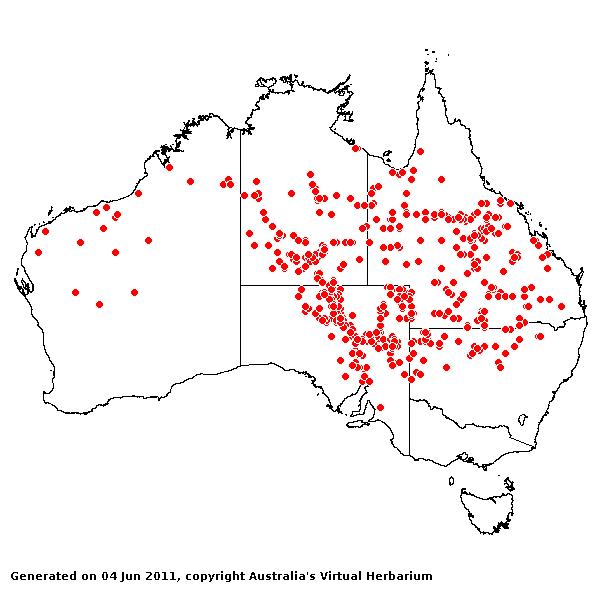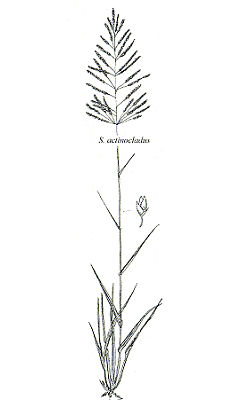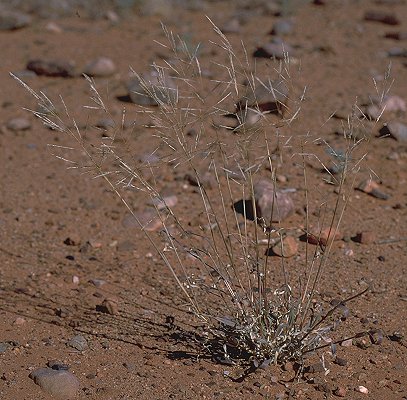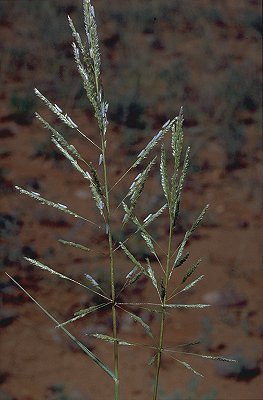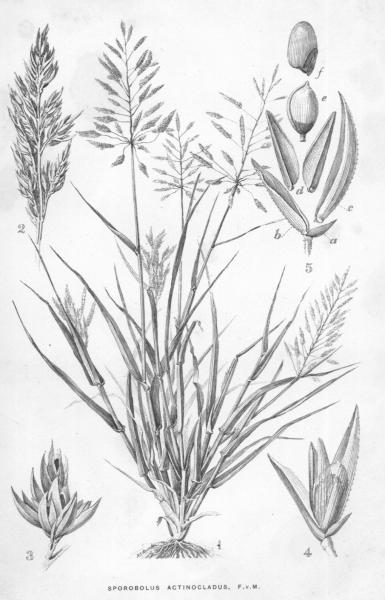Sporobolus actinocladus (F.Muell.) F.
Muell. Fragm. 8: 140 (1873).
Classification. (GPWG 2001) : Subfamily
Chloridoideae. Cynodonteae.
Basionym and/or
Replacement Name: Vilfa
actinoclada F. Muell., Fragm. 6: 84 (1867).
Type of Basionym or
Protologue Information: HT: F. Mueller s.n., Australia: Sturts Creek
(MEL (photo, BRI); IT: K (photo, BRI)).
Key references
(books and floras): [1878] G.Bentham, Flora Australiensis 7 (623),
[1952] C.A.Gardner, Flora of Western Australia 1 Gramineae (163),
[1981] M.Lazarides in J.Jessop (ed)., Flora of Central Australia (468),
[2002] D.Sharp & B.K.Simon, AusGrass, Grasses of Australia, [2006]
J.Jessop, G.R.M.Dashorst, F.M.James, Grasses of South Australia (396),
[2008] S.W.L.Jacobs, R.D.B.Walley & D.J.B.Wheeler, Grasses of New South
Wales (375).
Illustrations:
[1952] C.A.Gardner, Flora of Western Australia 1 Gramineae (161,
Pl. 48), [2006] J.Jessop, G.R.M.Dashorst, F.M.James, Grasses of South
Australia (396, Fig. 327), [2008]
S.W.L.Jacobs, R.D.B.Whalley & D.J.B.Wheeler, Grasses of New South Wales,
4th edn (375).
Habit. Annual
or perennial. Culms erect, 15–80 cm tall. Lateral branches simple or sparsely
branched. Ligule a fringe of hairs, 0.5–1 mm long. Leaf-blades linear or
lanceolate, flat, 1.5–20 cm long, 3–6 mm wide. Leaf-blade surface scaberulous.
Inflorescence.
Inflorescence compound, a panicle. Panicle pyramidal, 5–18 cm long, 2.5–8 cm
wide, contracted about primary branches.
Spikelets.
Spikelets sessile or pedicelled. Fertile spikelets 1-flowered, comprising 1
fertile floret(s), without rachilla extension, lanceolate, terete, 1–2 mm long.
Glumes. Lower
glume lanceolate or ovate, membranous, without keels, 0 -nerved. Upper glume
lanceolate or ovate, 0.5–1.5 mm long, membranous, keeled, 1-keeled, 1 -nerved.
Florets.
Fertile lemma 1–2 mm long, without keel, 1 -nerved. Palea 2 -nerved. Palea apex
entire. Anthers 3. Grain 0.75–0.8 mm long.
Continental
Distribution: Australasia.
Australian
Distribution: Western Australia, Northern Territory, South Australia,
Queensland, New South Wales.
Western Australia:
Gardner, Fitzgerald, Hall, Dampier. Canning, Keartland, Fortescue, Ashburton,
Austin. Northern Territory: Darwin & Gulf, Barkly Tableland, Central
Australia North, Central Australia South. South Australia:
North-western, Lake Eyre, Gairdner-Torrens Basin, Flinders Ranges, Eastern,
Eyre Peninsula, Northern Lofty. Queensland: Burke, Cook, Gregory North,
Leichhardt, Maranoa, Mitchell, North Kennedy, Port Curtis, South Kennedy,
Warrego, Darling Downs, Gregory South. New South Wales: North-Western Plains,
South Far Western Plains.
Notes.
A distinctive species with spikelets aggregated towards the apices of
inflorescence branches. A number of specimens from Central Australia have
short, broad, dense false spikes with the secondary branches twisted and
divergent rather than straight and appressed (P.K. Latz 6842A, Leach 1407,
Barritt 449, Mitchell 816). They have not been grouped into a separate
taxon as there is considerable variation within the species.
Endemic;
widely distributed in the summer rainfall dominated arid regions of all
mainland States except Vic. Most specimens have been collected along waterways;
flowers all year, in response to rain.

